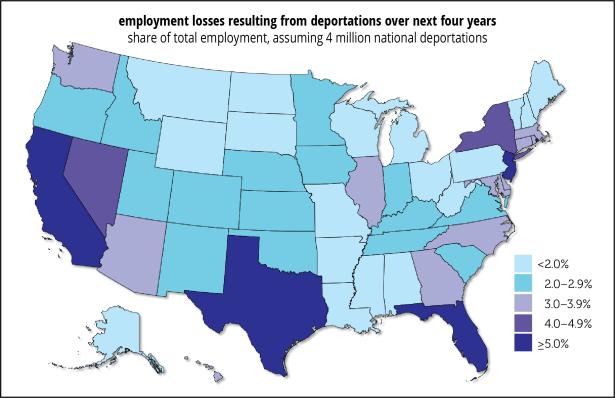As Trump and his ICE Sturmabteilung troop stormingly about the country deporting people, there’s an important fact that’s being overlooked: deporting undocumented workers destroys domestic jobs as well. Of course, their nativist campaign is grotesque and revolting in itself, and would be were no native-born bystanders injured by the expulsions. But we should be clear on what damage we’re doing to ourselves as well.
As Ben Zipperer shows in work for the Economic Policy Institute, almost as many native-born workers could lose their jobs as deported immigrants. Using data from the experience of the Secure Communities Program (SCP), a deportation effort launched by the Bush administration in 2008 and expanded under Obama, he finds that the far more ambitious Trump program will hammer native-born employment almost as much as it does foreign-born.
The SCP was small potatoes next to the current program. It resulted in the deportation of more than 450,000 people—not a small number, but only a fraction of what Trump & Co. have in mind. They’re looking to expel a million people a year, roughly three times the immediate pre-Trump rate. But the experience is a useful basis for predicting what might happen over the next three-and-a-half years.
Based on the effects of SCP deportations, Zipperer estimates that over that period, 3.3 million jobs held by immigrants will disappear, plus another 2.6 million held by native-born, for a total of 5.9 million—almost 4% of current total employment. In other words, for every 1,000 immigrants who lose their jobs, almost 800 natives will as well.
It’a not just jobs that will be lost. Zipperer draws on earlier work by, among several others, Troup Howard, Mengqi Wang, and Dayin Zhang that looked at the effects of the SCP on the construction industry. Since the program was too large to implement nationally all at once, it was rolled out in staggered form across the country, allowing comparisons between counties where deportations were well underway to those where it wasn’t introduced yet. They found that counties where the program was introduced exhibited “large and persistent reductions in construction workforce, residential homebuilding, and increases in home prices.” Contrary to the hopes of deporters, native-born workers did not replace the deported foreign-born, nor did native wages rise significantly.
Deporters also claim that immigrants have been raising housing costs and reducing supply for natives. Howard et al.’s work suggests otherwise. While reducing immigrant demand for housing reduced costs briefly, after that brief dip, the hit to new construction led to higher prices and reduced availability over the longer term. As they put it, immigrant labor and native labor are complementary, not in opposition to each other.
According to Zipperer, the effects will be highly concentrated by sector, with 42% of the losses occurring in construction (19% of that sector’s employment), with almost 40% of those job losses hitting natives. As he puts it, “when there are fewer immigrant roofers and framers to build the basic structure of homes, there will be less work available for U.S.-born electricians and plumbers.”
Another sector taking a big hit will be childcare. Though much smaller than construction, deportations could take out 15% of the sector’s jobs—bad news for parents already struggling to find someone to take care of their kids while they work, not to mention for the deportees.
And although job losses are likely to hit every state—nationally, losses will be just over half as large as those between 2008 and 2010, the Great Recession—the effects will be concentrated in a few, notably California, Texas, Florida, New Jersey, Nevada, and New York. (Map below.) For three states—Texas, New York, and Massachusetts—projected job losses will be larger than they were in the Great Recession.

We’re already seeing early signs of job loss in California. Using Current Population Survey data, researchers at the University of California Merced found the number of people reporting for private sector work was down 3.1% from May 11 to June 8—with citizens down more than noncitizens. Deportations intensified after June 6, so things were just getting going by the closing date of the UC Merced study. The didn’t find similar developments in other states, but California has been a deportation headliner and may be a taste of things to come.
And we’re already seeing early signs of a hit to construction nationally. As the graph below shows, job growth in construction was running well ahead of overall growth from 2022 (when the job market began to stabilize after the covid shock) into late 2024. Since the election, and especially since the inauguration, construction’s advantage has disappeared, and is now running behind overall growth. Of course, with Trump purging the Bureau of Labor Statistics, we may not have data like this in the coming months.

Can we take all this winning?


Spread the word